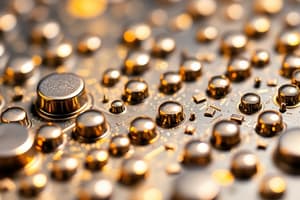Podcast
Questions and Answers
What property enables metals to be bent without breaking and stretched without tearing?
What property enables metals to be bent without breaking and stretched without tearing?
- Density
- Ductility
- Thermal stability
- Malleability (correct)
Which of the following is a common characteristic of non-metals?
Which of the following is a common characteristic of non-metals?
- Covalent bonding (correct)
- High melting points
- High density
- Excellent electricity conduction
What is the main reason non-metals are considered poor conductors of heat and electricity?
What is the main reason non-metals are considered poor conductors of heat and electricity?
- They form covalent bonds (correct)
- They have high density
- They lack lustre
- They transfer heat easily
Which type of element is carbon when in a non-metallic form?
Which type of element is carbon when in a non-metallic form?
How do metal elements contribute to various industries?
How do metal elements contribute to various industries?
Study Notes
Understanding Metals and Non-Metals
In our everyday lives, we interact with materials like aluminum pots, iron nails, glass windows, rubber tires, and salt crystals. These diverse materials can all be categorized into two main groups based on their chemical properties—metals and non-metals. Let's delve deeper into these fundamental building blocks of matter by exploring what makes them unique.
What is a Metal?
A metal is defined as a material that conducts electricity well due to its ability to freely move electrons throughout its structure when subjected to an electric current. Metallic elements generally have characteristic luster, malleability (capable of being hammered into thin sheets), ductility (easily drawn out into fine wires), high density, and reactivity towards acids. Common examples of metals include gold, silver, copper, lead, iron, and aluminum.
Properties and Characteristics
- Electrical Conductivity: As mentioned earlier, metals possess this property because of the free movement of electrons within their crystal lattice structure.
- Lustrous Appearance: Pure metallic elements often exhibit a mirror-like shine except under certain conditions where corrosion has occurred. This shiny appearance arises from the reflected light off their smooth surfaces.
- Malleability & Ductility: Metal atoms typically arrange themselves into a regular pattern called a lattice, allowing them to slide easily past one another upon external force. This enables metals to be bent without breaking (malleability) and stretched without tearing (ductility).
- High Density: Compared to other types of matter, such as gases and liquids, metals tend to have higher densities per unit volume. For example, water, which is quite dense compared to air, weighs only 8 grams per milliliter while aluminum weighs nearly twice as much – approximately 2.7 grams per cubic centimeter.
Applications of Metals
Metal elements form the basis of many technological advancements across industries, including transportation, construction, electronics, energy production, and medicine. Their exceptional mechanical strength, thermal stability, and electrical conductivity make them indispensable resources for the creation of various tools, utensils, structures, and devices.
What is a Non-Metal?
Non-metals, also known as non-conductors, do not transfer heat or electricity through free-flowing electrons; instead, they rely on mechanisms such as molecular motion for conducting heat or ion flow for conveying charge. Unlike metals, non-metals lack lustre, are poor conductors of both heat and electricity, and have low melting points. Examples of non-metals include carbon (in elemental form as graphite or diamond), hydrogen, nitrogen, oxygen, sulfur, chlorine, phosphorus, iodine, and many more.
Properties and Characteristics
Though non-metals vary widely among each other, there are several common characteristics that define them as a group:
- Poor Electricity and Heat Conduction: Non-metals do not share electrons readily between molecules or atoms, making it difficult for electrons to travel freely and conduct electricity or heat.
- Low Melting Points: In most cases, non-metals require less energy to change state from solid to liquid, leading to lower melting points relative to metals.
- Covalent Bonding: Non-metals form covalent bonds, which involve sharing electrons rather than transferring them, giving rise to stable atomic arrangements in molecules.
Applications of Non-Metals
The chemistry, physics, and engineering sectors benefit greatly from the utilization of non-metal elements. Some applications include catalysts in industrial processes, lubricants, insulators, semiconductors, pharmaceuticals, polymers, plastics, fertilizers, and medicines. Given their wide range of uses, non-metals contribute significantly to modern society despite being fundamentally different from metals.
Studying That Suits You
Use AI to generate personalized quizzes and flashcards to suit your learning preferences.
Description
Explore the distinctive characteristics and applications of metals and non-metals in the realm of materials science. Learn about their electrical conductivity, malleability, lustrous appearance, covalent bonding, and much more.




